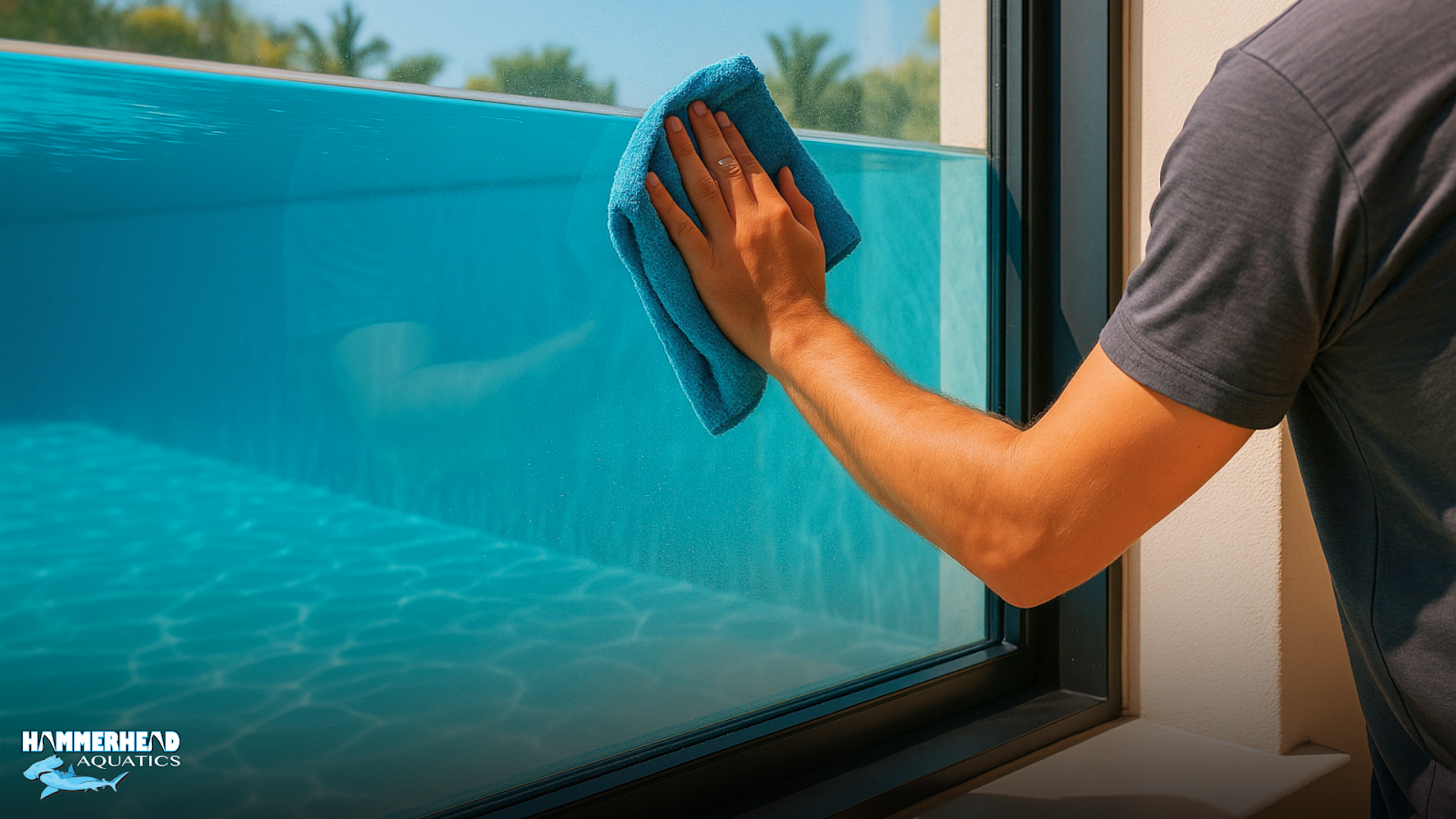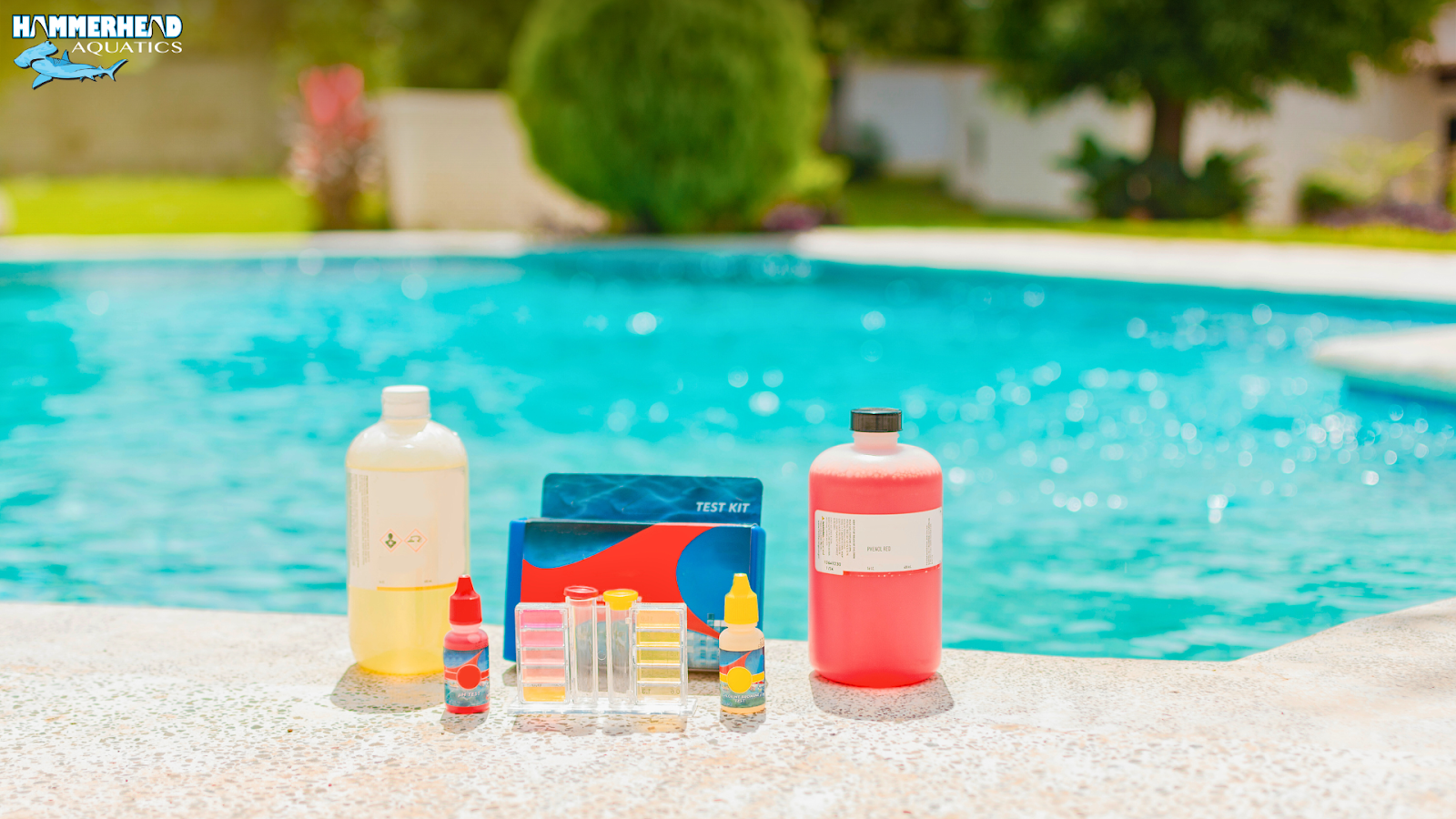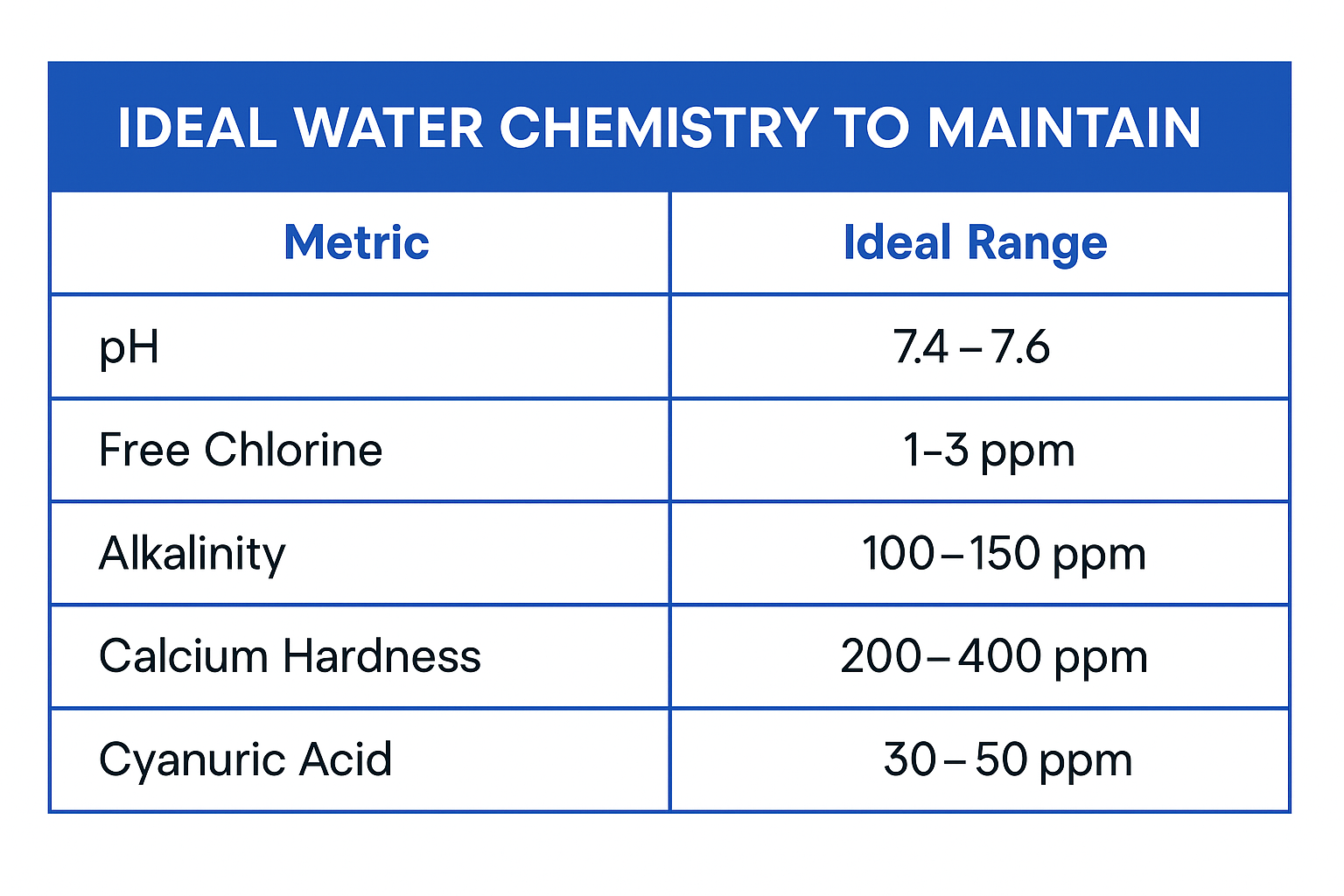Guide To Pool Window Maintenance And Cleaning Maintenance (Step-by-step) For Year-Round Quality [2025]


You have probably read tons of articles on how to maintain a pool or how to clean the pool surface. Those guides are like telling you that it’s a generic process. But what they don’t tell you is that it’s a completely different story if you have invested in building fabulous pool windows.
With all my experience, I have learnt that you need to know how to care for each part of your pool, and it’s not as straightforward as “10 things to do to maintain your pool.” At least, not for luxurious features such as pool windows.
| I’ve worked on dozens of pools with glass and acrylic viewing windows—from high-end rooftop installations to backyard plunge pools. And I’ve learned something simple but important: pool windows need extra attention.
A fuzzy or scratch-prone pool window can ruin the stunning look of the whole pool, and if not taken care of well, it might get too expensive to handle the case.
That’s why, today, I’ve decided to prepare this step-by-step guide to help you maintain pool windows in the best way possible and keep your pool’s fresh look alive for the long-term.
Whether your window is made of glass or acrylic, I’ll walk you through the real-world maintenance steps that keep it looking like new.
Let’s begin.
TL;DR: Pool Window Maintenance & Cleaning Step-by-step
- Rinse weekly with clean water
- Clean monthly with mild soap and a soft cloth or sponge
- NEVER use abrasives, high-pressure water, or harsh chemicals
- For acrylic: avoid ammonia and alcohol-based cleaners entirely
- For underwater windows, use soft pool-safe tools
- Keep water chemistry balanced to prevent buildup and damage
- Inspect seals and edges seasonally to catch early wear
- For already highly scratched or fuzzy pool windows, contact experts such as Hammerhead pools to help you fix it
Pro tip: Treat your pool window like you would a car windshield—clean it before it looks dirty, and you’ll avoid most problems altogether.
Now let’s go deeper—literally.
How To Clean A Pool Window (Dry Side) - 3 Steps

Whether your pool window faces your living room, a hallway, or the backyard, the dry side needs routine attention.
What You’ll Need To Carry Out The Process
- A hose with clean water (for pre-rinse)
- A bucket of warm water with a few drops of mild dish soap
- A soft microfiber cloth, sponge, or soft mop head
- A dry microfiber towel for finishing (optional but recommended)
Step 1 - Rinse Dry Side Weekly
- Use a low-pressure hose and spray the entire window down with clean water to remove loose dirt and dust.
But if you have a rooftop pool or a pool attached to a living space, spraying water is not an option. In this case, you may use a bucket of water and a scratch-free microfiber sponge—soak the sponge with water and gently rinse the window surface. - And then rinse the window surface using a dry scratch-free microfiber sponge, or using a microfiber towel to remove remaining water droplets. This helps prevent scratching during the wash.
- You repeat this process every week.
Step 2 - Apply Soapy Water Every Month
- Follow the first part of Step 1 to rinse off any accumulating dirt.
- Next, take a bucket of water and mix it with a mild soap solution.
- Dip a microfiber towel or a scratch-free microfiber sponge into the soapy water. Use it to wipe gently in vertical or horizontal strokes.
Avoid scrubbing in circles or zig-zags as they are more likely to leave swirl marks or trails, especially on acrylic.
- Once done, use a bucket of clean water. Soak a second sponge in it and then rinse off the soap on the surface.
Do this multiple times because soap residue can dry hazy if not rinsed completely, especially in direct sunlight. - Follow up with a gentle rinse using a third, dry sponge to get rid of any remaining water droplets.
Step 3 - Check The Edges & Hardware For Grimes
- After following any of the above steps, look closely at the window frame and any fasteners or exposed hardware.
- If you notice any grime buildup, use a soft sponge or non-abrasive brush to get rid of them.
- If it doesn’t work, they try using a sponge with soapy water to rinse it, and then dry the area with a dry sponge.
Pro tip: Do not use paper towels. They can leave lint and can easily cause scratches on soft surfaces.
How To Clean The Underwater Side Of A Pool Window

Once you are done with the dry side, let’s move to the inner side of your pool window which is prone to film, scale, and algae formation.
What You’ll Need To Carry Out The Process
- A telescopic pool pole
- A soft sponge head or non-abrasive brush (specifically for acrylic/glass)
- Optional: underwater acrylic-safe mop
- Optional: pool flocculant if clarity is already poor
Step 1 - Prepare For The Cleaning.
- (Optional) Partially drain the pool water to a lower water level to expose the pool windows. Do this only when you are not comfortable cleaning the pool windows underwater.
- Turn Off Water Features Temporarily:
In case you have water jets near the window, consider switching them off to keep debris from stirring while cleaning. - Attach The Soft Cleaning Pad To The Pole
Only use pads marked safe for acrylic or glass. Never use metal bristles, pumice stones, or pool wall brushes on your window.
Step 2 - Start Cleaning Pool Windows
- Inspect To See Any Focused Formation
Take a closer look at pool windows to see if there is any cloudiness or mineral scaling, algae growth near seals, and any fine scratches.
(For fine scratches, you may need a separate procedure for polishing the pool window. This is best to be handled by experts such as Hammerhead Pools.) - Gently Scrub The Window Surface
Soak the pad on a cleaning agent and start scrubbing from the top and use straight, overlapping strokes. Focus more on areas where cloudiness, mineral scaling, or algae growth is visible, but do not apply too much pressure. Your goal is to dislodge any film, not polish. - Repeat As Frequently As NeededFor pool windows that haven’t been cleaned in months, you may need to do this 2–3 times over the week. You can’t expect to get it clean in one go as you do not have the option to use too much pressure while scrubbing. Even a microfiber material can scratch acrylics if you press too hard.
Step 3 - Let Your Filtration Take Over
- Clean Off The Surface With Water
Use a low-pressure hose to spray the window surface, cleaning it off the cleaning agent used. - Avoid Entering The Pool Water For The Next 1-2 hrs
If you have a proper filtration and water circulation system in place, then you simply need to let them take care of the rest. The cleaning agent and the rinsed of the film should be filtered out in about 1-2 hrs of time.
Acrylic vs. Glass: Special Cleaning Notes

If you have glass pool windows, keep in mind:
- Glass is scratch-resistant, but can still etch over time from minerals or aggressive scrubbing.
- You can use vinegar and baking soda paste (gently) to remove calcium spots.
- Avoid hard water drying. Rinse well, then wipe if needed.
If you have acrylic pool windows, keep in mind:
- Acrylic is softer, and scratches very easily
- Never use Windex, ammonia, alcohol, or abrasives on acrylic
- Mild dish soap and a microfiber cloth are your best friends
- For deep scratches/clouding, hire a professional for restoration.
(You may contact experts such as Hammerhead Pool or other experts in your area.)
Balanced Water Chemistry = Pool Window Longevity

Now, this is a common piece of education you will always get from pool expats. And I will do the same.
Your pool water chemistry directly affects your pool window, especially on the underwater side.
If you do not maintain it well, then you may notice,
- Calcium scaling on glass
- Etching or clouding on acrylic
- Algae streaks around window frames
- Sealant damage from corrosive water

Make sure to test your water weekly, and especially after rainstorms, parties, or pool refills.
- Here’s a quick guide to learn how to test your pool water the right way- Pool Water Testing Guide.
Seasonal Pool Window Maintenance Routine
Now, while all those were very revealing (at least I’d like to think so), we all have a common issue of accountability.
So I decide to propose the following routine for you to maintain pool windows:
✅ Dry-side cleaning (rinse + wipe), Weekly basis.
✅ Wet-side cleaning (underwater), Monthly basis.
✅ Inspect seals & edges every 3 months.
✅ You need to check monthly for scratches or hazing.
✅ I would recommend Polish (acrylic only) Yearly or as needed.
✅ Check water chemistry, Weekly basis.
[Important] What NOT To Do For Pool Window Maintenance And Cleaning
Make sure you follow these rules on what to absolutely avoid when clearing pool windows.
❌ Don’t use power washers or high-pressure spray on windows
❌ Don’t use abrasive scrub pads, steel wool, or scouring powders
❌ Don’t lean ladders or tools against the window
❌ Don’t ignore water chemistry and expect the window to stay clear
❌ Don’t attempt DIY scratch repair on acrylic—get a pro
Final Thoughts: Take The Time, Save The Window

Your pool window is the visual heart of your pool—but only if it’s clear and well-kept. A little consistency in how you clean, rinse, and inspect it will help you maintain its stunning outlook and help you keep your pool top-notch.
Remember, once the window starts to haze, scratch, or cloud, it's 10x harder to fix than to prevent. So, it’s better to follow a routine that can help you avoid trouble with your pool windows as much as possible.
For Cloudy Acrylic or Scratches, Call in the Pros
No matter how careful you are, acrylic windows can develop fine scratches, surface hazing, or dull spots over time, especially on the underwater side. These issues can’t always be fixed with regular cleaning. And trying to polish it yourself with the wrong equipment could make things worse.
At this point, you should always consider hiring professionals with a proven track record in handling pool windows.
At Hammerhead Pools, we’ve been working with high-end pool features—including acrylic window installation and restoration—for over two decades. Our team knows how to assess, restore, and protect these panels using the right tools, compounds, and safe polishing methods.
So if your pool window is starting to look a little tired—or you just want it to shine like new—we’re always happy to take a look. No pressure. Just practical help from people who’ve seen it all. Contact us here.
FAQ: Pool Window Maintenance & Cleaning
1. How often should I clean a pool window?
Rinse weekly, clean both sides monthly, and inspect the frame and seals quarterly.
2. Can I use vinegar or glass cleaner?
Only on glass—and even then, avoid ammonia-based cleaners. For acrylic, stick to mild dish soap and water only.
3. What if my pool window looks cloudy from the inside?
It’s often due to scaling or poor water chemistry. Clean it gently, and test your pH and calcium levels immediately.
4. Can I polish out acrylic scratches myself?
Minor surface hazing might be treatable, but deeper polishing should be done by a professional with the right tools and compounds.
5. Do I need to clean both sides of the window even if one is underwater?
Yes. Both sides collect buildup, especially if the water isn’t balanced or the pool is in heavy use.
Explore essential pool window maintenance tips, from routine pool window cleaning to techniques that help you clean pool windows safely. Keep your pool windows spotless and long-lasting.











